A Comparison of Traditional and Modern Costing Systems in Accounting
VerifiedAdded on 2021/10/29
|9
|1846
|161
Report
AI Summary
This report provides a comprehensive comparison between traditional and modern costing systems in management accounting. It begins by defining costing systems and their purpose, then delves into the specifics of both traditional and modern (Activity-Based Costing) approaches, outlining their advantages and disadvantages. The report highlights the evolution from traditional costing, which was prevalent in the mid-20th century, to the modern system developed to address the shortcomings of its predecessor. A key focus is on the allocation of indirect costs under each method and the subsequent impact on product profitability and decision-making. A case study is included to illustrate how the choice of costing system affects cost allocation, and how different parameters can lead to varied profitability assessments, ultimately influencing managerial decisions. The analysis shows that Activity-Based Costing offers a more accurate view of product profitability compared to the traditional method, which allocates costs based on a single parameter. The report concludes by emphasizing the superiority of modern costing in providing a more precise assessment of production costs and product profitability, supporting better-informed decision-making.
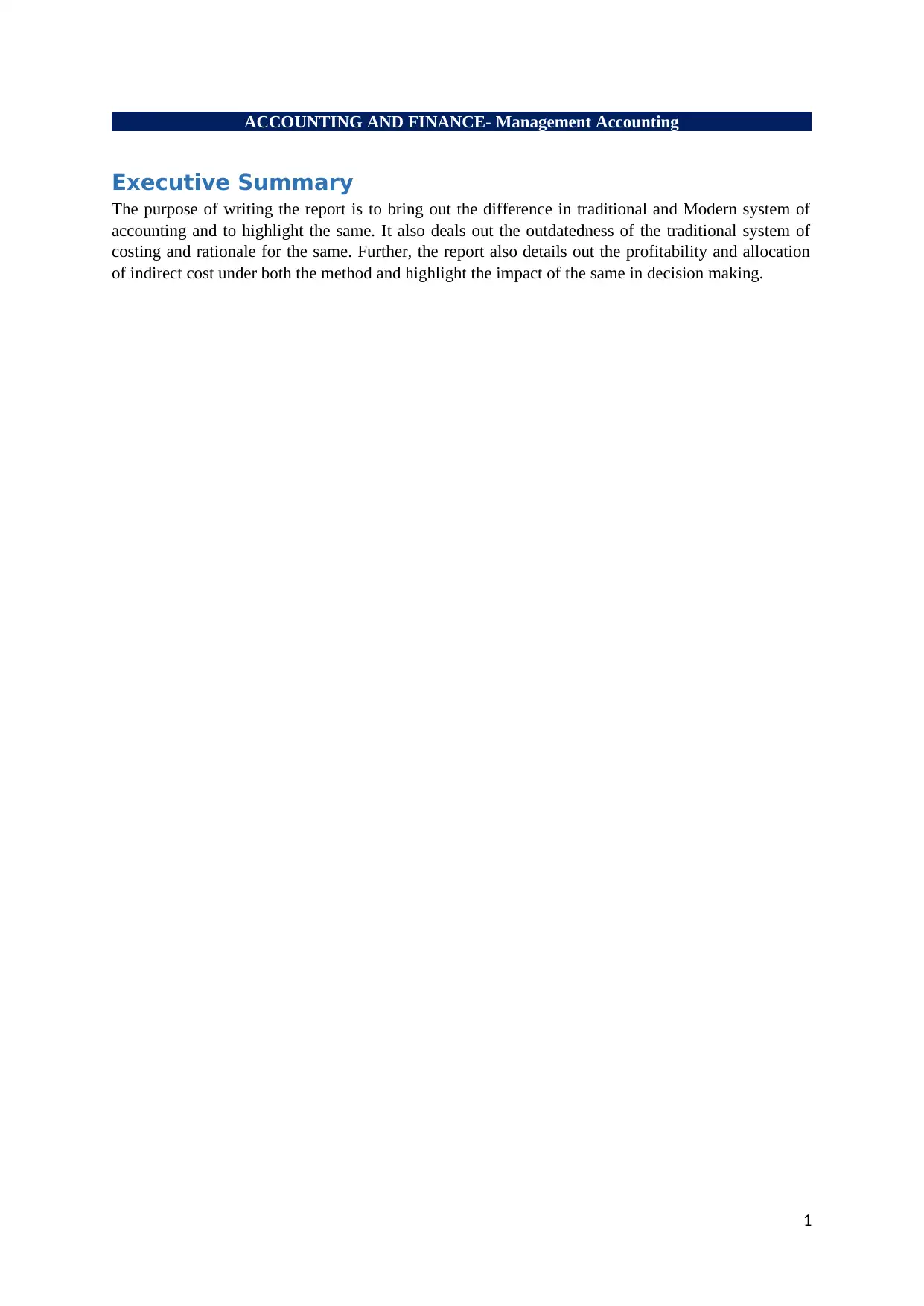
ACCOUNTING AND FINANCE- Management Accounting
Executive Summary
The purpose of writing the report is to bring out the difference in traditional and Modern system of
accounting and to highlight the same. It also deals out the outdatedness of the traditional system of
costing and rationale for the same. Further, the report also details out the profitability and allocation
of indirect cost under both the method and highlight the impact of the same in decision making.
1
Executive Summary
The purpose of writing the report is to bring out the difference in traditional and Modern system of
accounting and to highlight the same. It also deals out the outdatedness of the traditional system of
costing and rationale for the same. Further, the report also details out the profitability and allocation
of indirect cost under both the method and highlight the impact of the same in decision making.
1
Paraphrase This Document
Need a fresh take? Get an instant paraphrase of this document with our AI Paraphraser
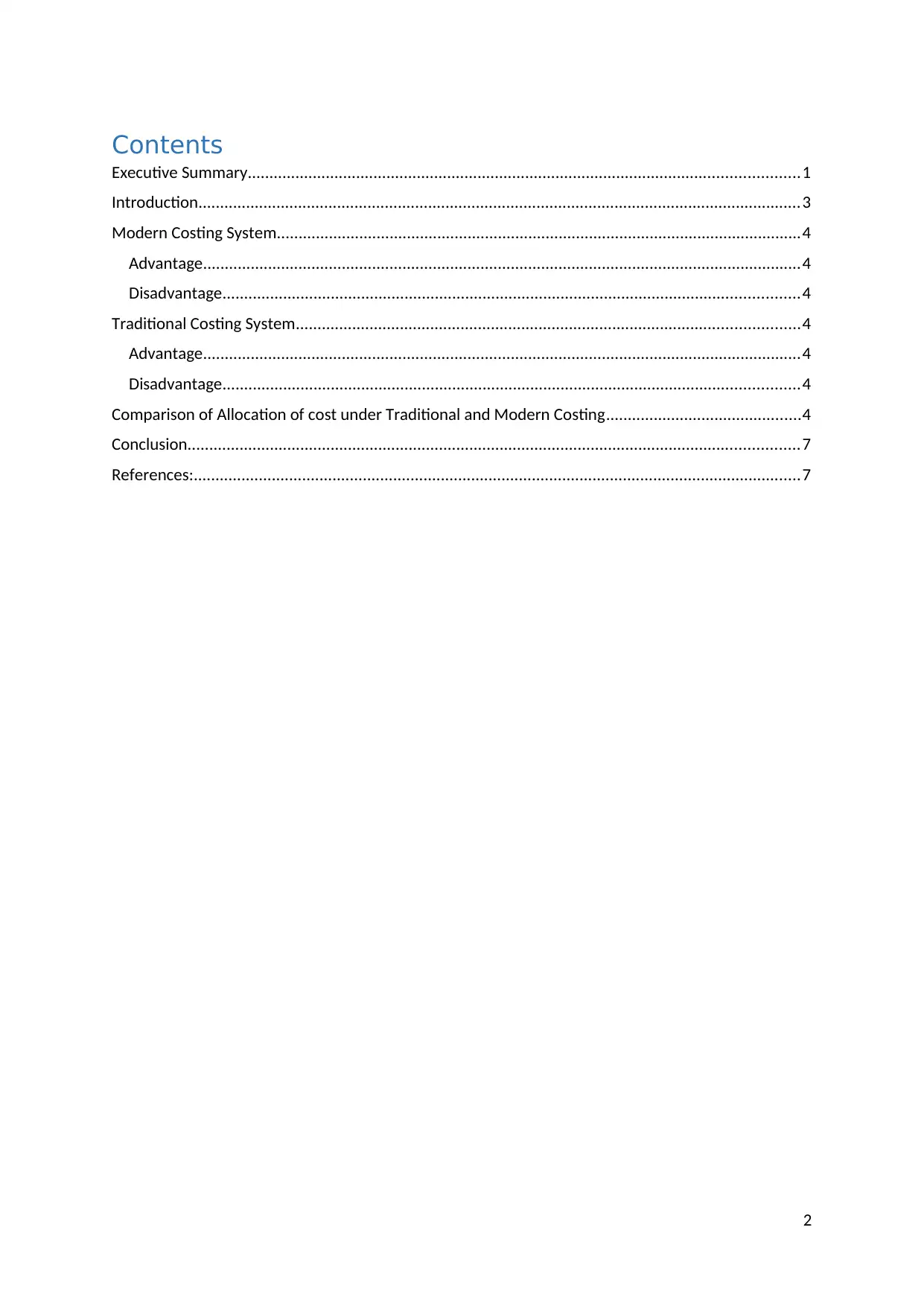
Contents
Executive Summary...............................................................................................................................1
Introduction...........................................................................................................................................3
Modern Costing System.........................................................................................................................4
Advantage..........................................................................................................................................4
Disadvantage.....................................................................................................................................4
Traditional Costing System....................................................................................................................4
Advantage..........................................................................................................................................4
Disadvantage.....................................................................................................................................4
Comparison of Allocation of cost under Traditional and Modern Costing.............................................4
Conclusion.............................................................................................................................................7
References:............................................................................................................................................7
2
Executive Summary...............................................................................................................................1
Introduction...........................................................................................................................................3
Modern Costing System.........................................................................................................................4
Advantage..........................................................................................................................................4
Disadvantage.....................................................................................................................................4
Traditional Costing System....................................................................................................................4
Advantage..........................................................................................................................................4
Disadvantage.....................................................................................................................................4
Comparison of Allocation of cost under Traditional and Modern Costing.............................................4
Conclusion.............................................................................................................................................7
References:............................................................................................................................................7
2
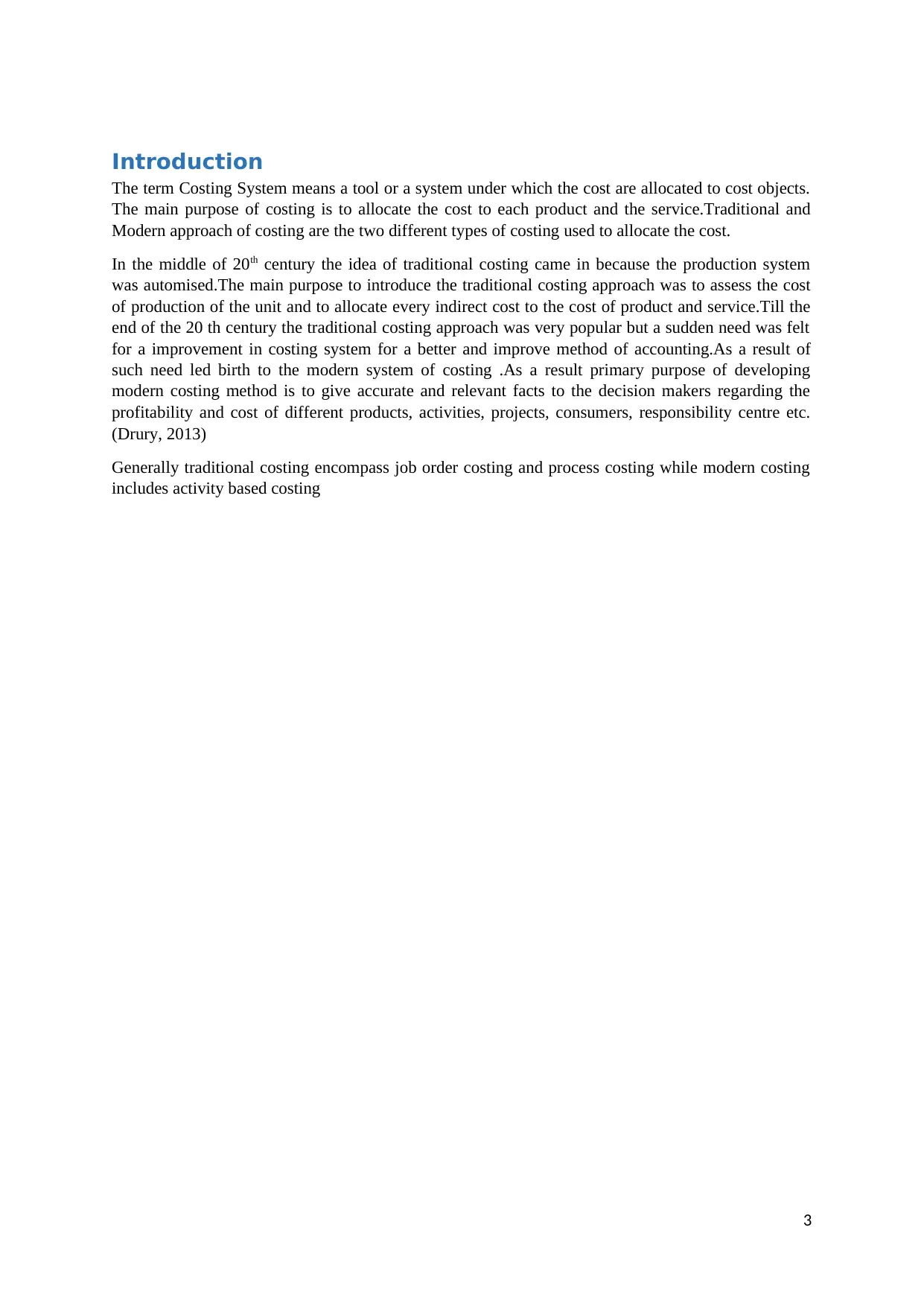
Introduction
The term Costing System means a tool or a system under which the cost are allocated to cost objects.
The main purpose of costing is to allocate the cost to each product and the service.Traditional and
Modern approach of costing are the two different types of costing used to allocate the cost.
In the middle of 20th century the idea of traditional costing came in because the production system
was automised.The main purpose to introduce the traditional costing approach was to assess the cost
of production of the unit and to allocate every indirect cost to the cost of product and service.Till the
end of the 20 th century the traditional costing approach was very popular but a sudden need was felt
for a improvement in costing system for a better and improve method of accounting.As a result of
such need led birth to the modern system of costing .As a result primary purpose of developing
modern costing method is to give accurate and relevant facts to the decision makers regarding the
profitability and cost of different products, activities, projects, consumers, responsibility centre etc.
(Drury, 2013)
Generally traditional costing encompass job order costing and process costing while modern costing
includes activity based costing
3
The term Costing System means a tool or a system under which the cost are allocated to cost objects.
The main purpose of costing is to allocate the cost to each product and the service.Traditional and
Modern approach of costing are the two different types of costing used to allocate the cost.
In the middle of 20th century the idea of traditional costing came in because the production system
was automised.The main purpose to introduce the traditional costing approach was to assess the cost
of production of the unit and to allocate every indirect cost to the cost of product and service.Till the
end of the 20 th century the traditional costing approach was very popular but a sudden need was felt
for a improvement in costing system for a better and improve method of accounting.As a result of
such need led birth to the modern system of costing .As a result primary purpose of developing
modern costing method is to give accurate and relevant facts to the decision makers regarding the
profitability and cost of different products, activities, projects, consumers, responsibility centre etc.
(Drury, 2013)
Generally traditional costing encompass job order costing and process costing while modern costing
includes activity based costing
3
⊘ This is a preview!⊘
Do you want full access?
Subscribe today to unlock all pages.

Trusted by 1+ million students worldwide
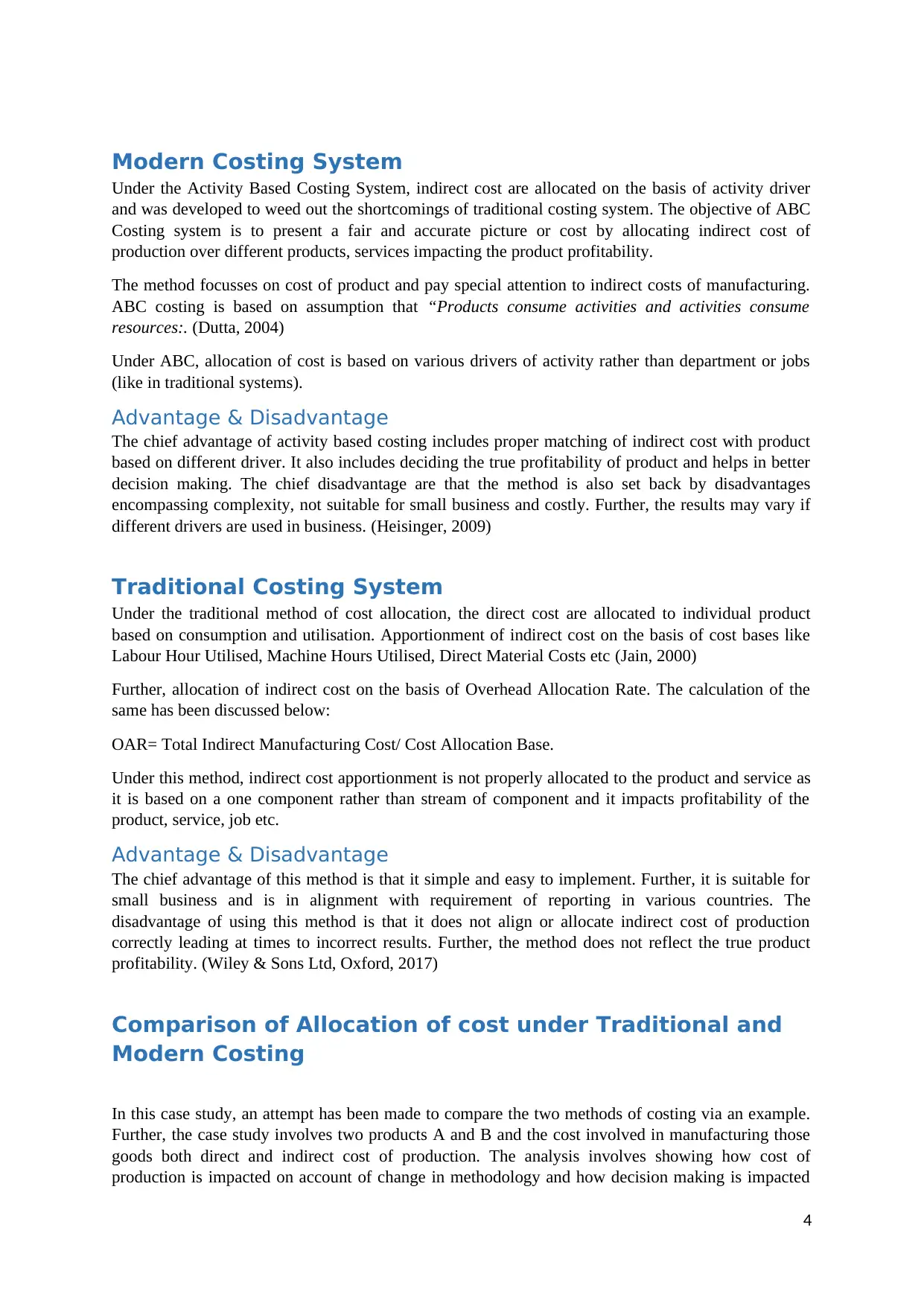
Modern Costing System
Under the Activity Based Costing System, indirect cost are allocated on the basis of activity driver
and was developed to weed out the shortcomings of traditional costing system. The objective of ABC
Costing system is to present a fair and accurate picture or cost by allocating indirect cost of
production over different products, services impacting the product profitability.
The method focusses on cost of product and pay special attention to indirect costs of manufacturing.
ABC costing is based on assumption that “Products consume activities and activities consume
resources:. (Dutta, 2004)
Under ABC, allocation of cost is based on various drivers of activity rather than department or jobs
(like in traditional systems).
Advantage & Disadvantage
The chief advantage of activity based costing includes proper matching of indirect cost with product
based on different driver. It also includes deciding the true profitability of product and helps in better
decision making. The chief disadvantage are that the method is also set back by disadvantages
encompassing complexity, not suitable for small business and costly. Further, the results may vary if
different drivers are used in business. (Heisinger, 2009)
Traditional Costing System
Under the traditional method of cost allocation, the direct cost are allocated to individual product
based on consumption and utilisation. Apportionment of indirect cost on the basis of cost bases like
Labour Hour Utilised, Machine Hours Utilised, Direct Material Costs etc (Jain, 2000)
Further, allocation of indirect cost on the basis of Overhead Allocation Rate. The calculation of the
same has been discussed below:
OAR= Total Indirect Manufacturing Cost/ Cost Allocation Base.
Under this method, indirect cost apportionment is not properly allocated to the product and service as
it is based on a one component rather than stream of component and it impacts profitability of the
product, service, job etc.
Advantage & Disadvantage
The chief advantage of this method is that it simple and easy to implement. Further, it is suitable for
small business and is in alignment with requirement of reporting in various countries. The
disadvantage of using this method is that it does not align or allocate indirect cost of production
correctly leading at times to incorrect results. Further, the method does not reflect the true product
profitability. (Wiley & Sons Ltd, Oxford, 2017)
Comparison of Allocation of cost under Traditional and
Modern Costing
In this case study, an attempt has been made to compare the two methods of costing via an example.
Further, the case study involves two products A and B and the cost involved in manufacturing those
goods both direct and indirect cost of production. The analysis involves showing how cost of
production is impacted on account of change in methodology and how decision making is impacted
4
Under the Activity Based Costing System, indirect cost are allocated on the basis of activity driver
and was developed to weed out the shortcomings of traditional costing system. The objective of ABC
Costing system is to present a fair and accurate picture or cost by allocating indirect cost of
production over different products, services impacting the product profitability.
The method focusses on cost of product and pay special attention to indirect costs of manufacturing.
ABC costing is based on assumption that “Products consume activities and activities consume
resources:. (Dutta, 2004)
Under ABC, allocation of cost is based on various drivers of activity rather than department or jobs
(like in traditional systems).
Advantage & Disadvantage
The chief advantage of activity based costing includes proper matching of indirect cost with product
based on different driver. It also includes deciding the true profitability of product and helps in better
decision making. The chief disadvantage are that the method is also set back by disadvantages
encompassing complexity, not suitable for small business and costly. Further, the results may vary if
different drivers are used in business. (Heisinger, 2009)
Traditional Costing System
Under the traditional method of cost allocation, the direct cost are allocated to individual product
based on consumption and utilisation. Apportionment of indirect cost on the basis of cost bases like
Labour Hour Utilised, Machine Hours Utilised, Direct Material Costs etc (Jain, 2000)
Further, allocation of indirect cost on the basis of Overhead Allocation Rate. The calculation of the
same has been discussed below:
OAR= Total Indirect Manufacturing Cost/ Cost Allocation Base.
Under this method, indirect cost apportionment is not properly allocated to the product and service as
it is based on a one component rather than stream of component and it impacts profitability of the
product, service, job etc.
Advantage & Disadvantage
The chief advantage of this method is that it simple and easy to implement. Further, it is suitable for
small business and is in alignment with requirement of reporting in various countries. The
disadvantage of using this method is that it does not align or allocate indirect cost of production
correctly leading at times to incorrect results. Further, the method does not reflect the true product
profitability. (Wiley & Sons Ltd, Oxford, 2017)
Comparison of Allocation of cost under Traditional and
Modern Costing
In this case study, an attempt has been made to compare the two methods of costing via an example.
Further, the case study involves two products A and B and the cost involved in manufacturing those
goods both direct and indirect cost of production. The analysis involves showing how cost of
production is impacted on account of change in methodology and how decision making is impacted
4
Paraphrase This Document
Need a fresh take? Get an instant paraphrase of this document with our AI Paraphraser
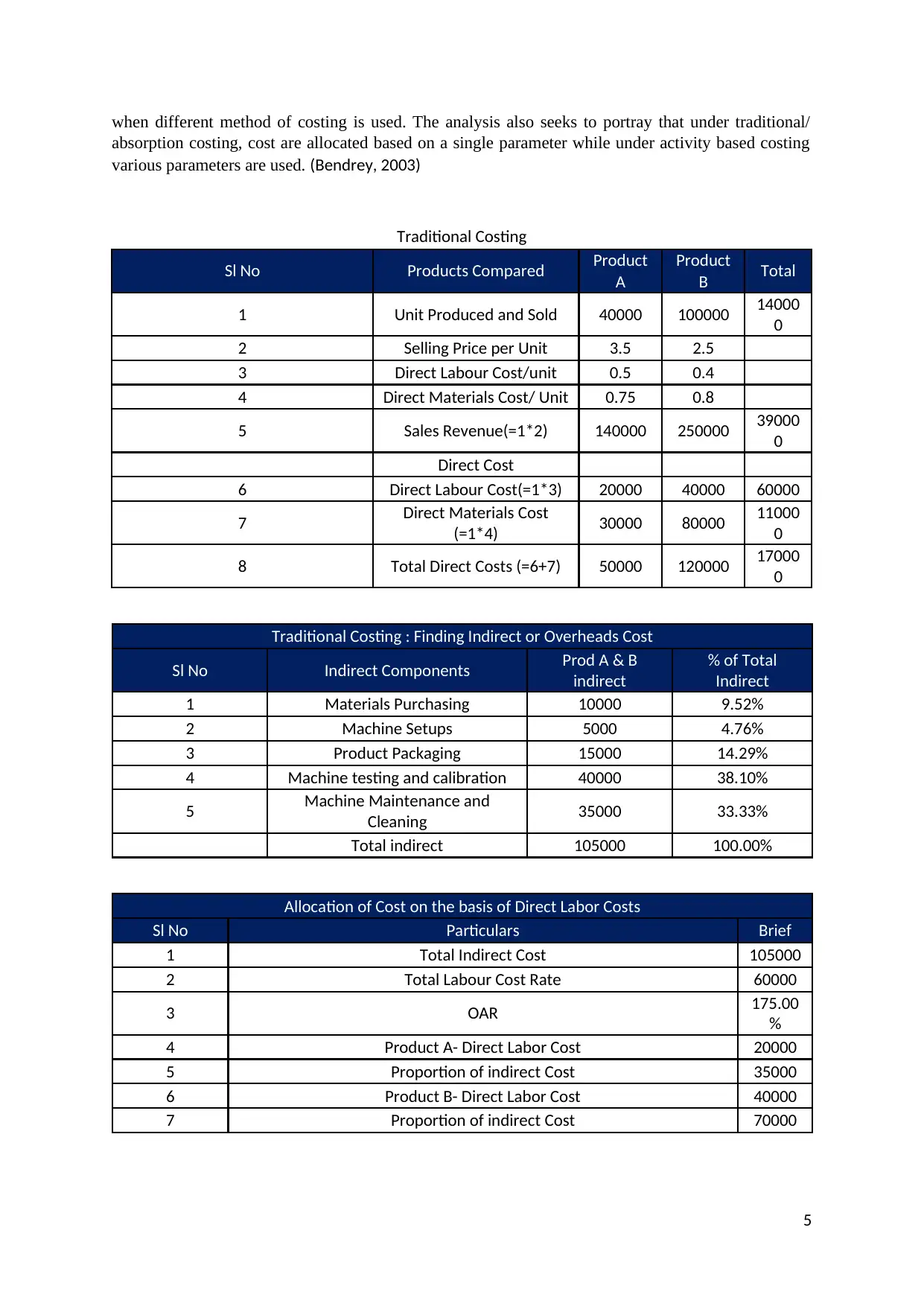
when different method of costing is used. The analysis also seeks to portray that under traditional/
absorption costing, cost are allocated based on a single parameter while under activity based costing
various parameters are used. (Bendrey, 2003)
Traditional Costing
Sl No Products Compared Product
A
Product
B Total
1 Unit Produced and Sold 40000 100000 14000
0
2 Selling Price per Unit 3.5 2.5
3 Direct Labour Cost/unit 0.5 0.4
4 Direct Materials Cost/ Unit 0.75 0.8
5 Sales Revenue(=1*2) 140000 250000 39000
0
Direct Cost
6 Direct Labour Cost(=1*3) 20000 40000 60000
7 Direct Materials Cost
(=1*4) 30000 80000 11000
0
8 Total Direct Costs (=6+7) 50000 120000 17000
0
Traditional Costing : Finding Indirect or Overheads Cost
Sl No Indirect Components Prod A & B
indirect
% of Total
Indirect
1 Materials Purchasing 10000 9.52%
2 Machine Setups 5000 4.76%
3 Product Packaging 15000 14.29%
4 Machine testing and calibration 40000 38.10%
5 Machine Maintenance and
Cleaning 35000 33.33%
Total indirect 105000 100.00%
Allocation of Cost on the basis of Direct Labor Costs
Sl No Particulars Brief
1 Total Indirect Cost 105000
2 Total Labour Cost Rate 60000
3 OAR 175.00
%
4 Product A- Direct Labor Cost 20000
5 Proportion of indirect Cost 35000
6 Product B- Direct Labor Cost 40000
7 Proportion of indirect Cost 70000
5
absorption costing, cost are allocated based on a single parameter while under activity based costing
various parameters are used. (Bendrey, 2003)
Traditional Costing
Sl No Products Compared Product
A
Product
B Total
1 Unit Produced and Sold 40000 100000 14000
0
2 Selling Price per Unit 3.5 2.5
3 Direct Labour Cost/unit 0.5 0.4
4 Direct Materials Cost/ Unit 0.75 0.8
5 Sales Revenue(=1*2) 140000 250000 39000
0
Direct Cost
6 Direct Labour Cost(=1*3) 20000 40000 60000
7 Direct Materials Cost
(=1*4) 30000 80000 11000
0
8 Total Direct Costs (=6+7) 50000 120000 17000
0
Traditional Costing : Finding Indirect or Overheads Cost
Sl No Indirect Components Prod A & B
indirect
% of Total
Indirect
1 Materials Purchasing 10000 9.52%
2 Machine Setups 5000 4.76%
3 Product Packaging 15000 14.29%
4 Machine testing and calibration 40000 38.10%
5 Machine Maintenance and
Cleaning 35000 33.33%
Total indirect 105000 100.00%
Allocation of Cost on the basis of Direct Labor Costs
Sl No Particulars Brief
1 Total Indirect Cost 105000
2 Total Labour Cost Rate 60000
3 OAR 175.00
%
4 Product A- Direct Labor Cost 20000
5 Proportion of indirect Cost 35000
6 Product B- Direct Labor Cost 40000
7 Proportion of indirect Cost 70000
5
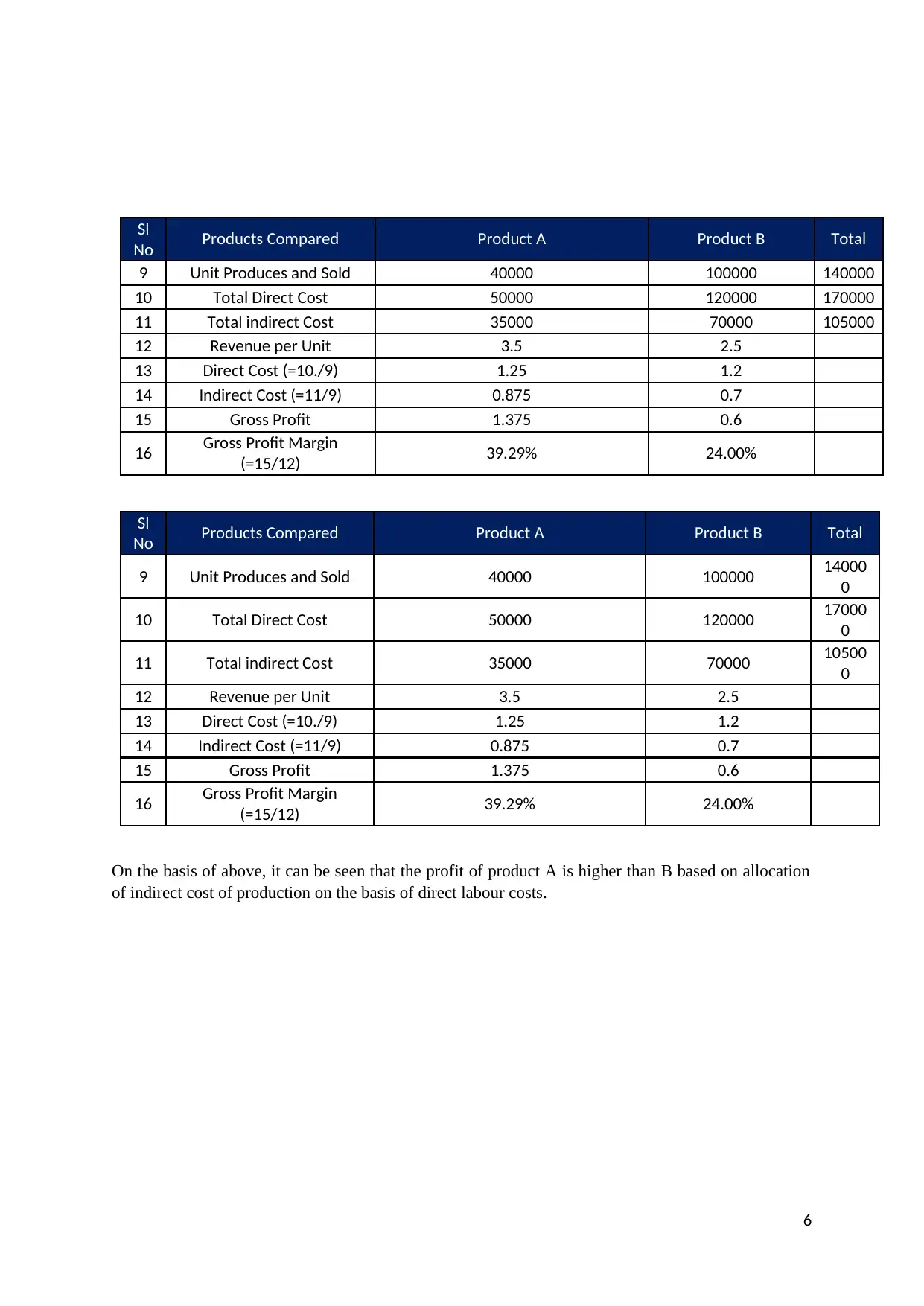
Sl
No Products Compared Product A Product B Total
9 Unit Produces and Sold 40000 100000 140000
10 Total Direct Cost 50000 120000 170000
11 Total indirect Cost 35000 70000 105000
12 Revenue per Unit 3.5 2.5
13 Direct Cost (=10./9) 1.25 1.2
14 Indirect Cost (=11/9) 0.875 0.7
15 Gross Profit 1.375 0.6
16 Gross Profit Margin
(=15/12) 39.29% 24.00%
Sl
No Products Compared Product A Product B Total
9 Unit Produces and Sold 40000 100000 14000
0
10 Total Direct Cost 50000 120000 17000
0
11 Total indirect Cost 35000 70000 10500
0
12 Revenue per Unit 3.5 2.5
13 Direct Cost (=10./9) 1.25 1.2
14 Indirect Cost (=11/9) 0.875 0.7
15 Gross Profit 1.375 0.6
16 Gross Profit Margin
(=15/12) 39.29% 24.00%
On the basis of above, it can be seen that the profit of product A is higher than B based on allocation
of indirect cost of production on the basis of direct labour costs.
6
No Products Compared Product A Product B Total
9 Unit Produces and Sold 40000 100000 140000
10 Total Direct Cost 50000 120000 170000
11 Total indirect Cost 35000 70000 105000
12 Revenue per Unit 3.5 2.5
13 Direct Cost (=10./9) 1.25 1.2
14 Indirect Cost (=11/9) 0.875 0.7
15 Gross Profit 1.375 0.6
16 Gross Profit Margin
(=15/12) 39.29% 24.00%
Sl
No Products Compared Product A Product B Total
9 Unit Produces and Sold 40000 100000 14000
0
10 Total Direct Cost 50000 120000 17000
0
11 Total indirect Cost 35000 70000 10500
0
12 Revenue per Unit 3.5 2.5
13 Direct Cost (=10./9) 1.25 1.2
14 Indirect Cost (=11/9) 0.875 0.7
15 Gross Profit 1.375 0.6
16 Gross Profit Margin
(=15/12) 39.29% 24.00%
On the basis of above, it can be seen that the profit of product A is higher than B based on allocation
of indirect cost of production on the basis of direct labour costs.
6
⊘ This is a preview!⊘
Do you want full access?
Subscribe today to unlock all pages.

Trusted by 1+ million students worldwide
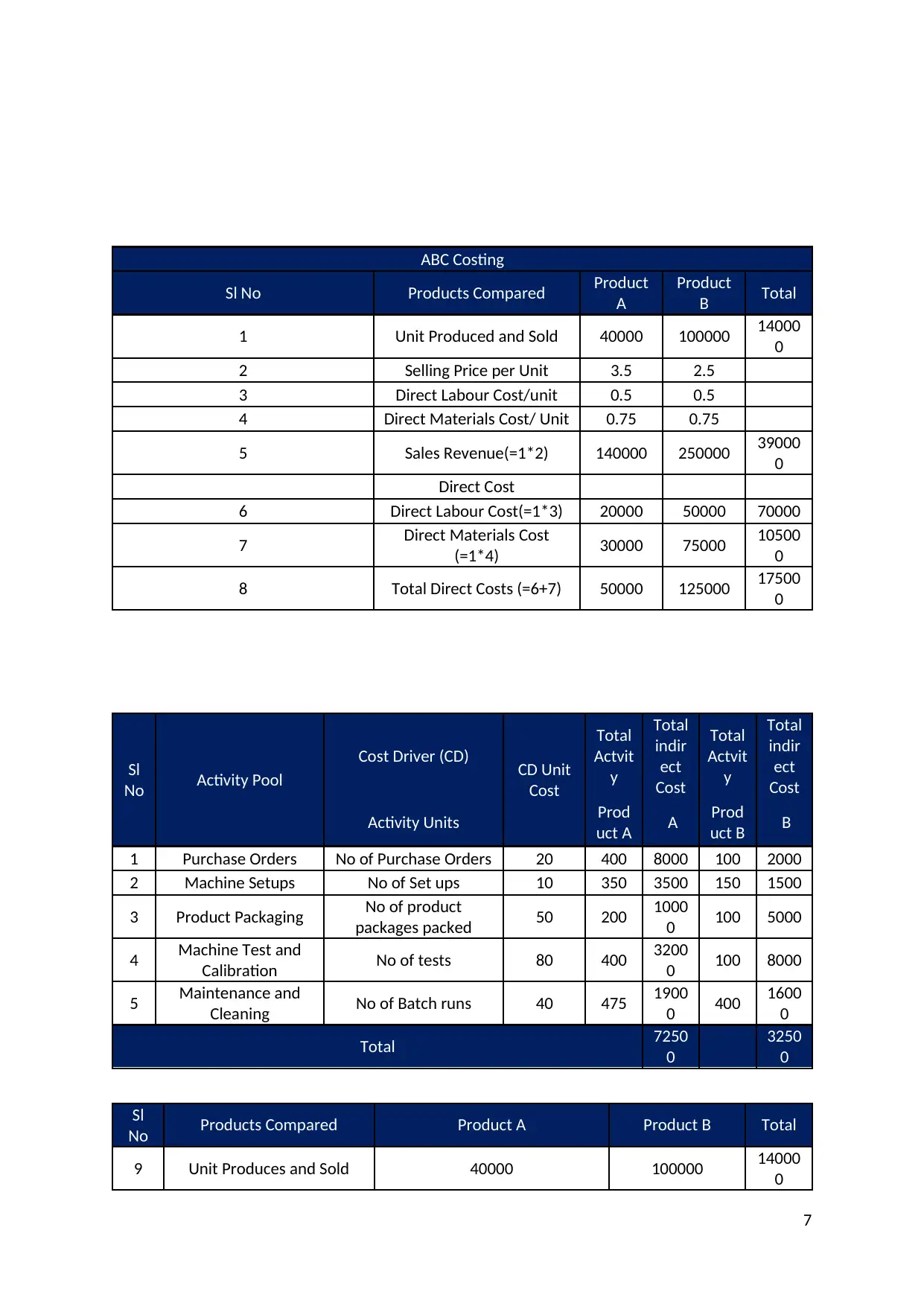
ABC Costing
Sl No Products Compared Product
A
Product
B Total
1 Unit Produced and Sold 40000 100000 14000
0
2 Selling Price per Unit 3.5 2.5
3 Direct Labour Cost/unit 0.5 0.5
4 Direct Materials Cost/ Unit 0.75 0.75
5 Sales Revenue(=1*2) 140000 250000 39000
0
Direct Cost
6 Direct Labour Cost(=1*3) 20000 50000 70000
7 Direct Materials Cost
(=1*4) 30000 75000 10500
0
8 Total Direct Costs (=6+7) 50000 125000 17500
0
Sl
No Activity Pool
Cost Driver (CD) CD Unit
Cost
Total
Actvit
y
Total
indir
ect
Cost
Total
Actvit
y
Total
indir
ect
Cost
Activity Units Prod
uct A A Prod
uct B B
1 Purchase Orders No of Purchase Orders 20 400 8000 100 2000
2 Machine Setups No of Set ups 10 350 3500 150 1500
3 Product Packaging No of product
packages packed 50 200 1000
0 100 5000
4 Machine Test and
Calibration No of tests 80 400 3200
0 100 8000
5 Maintenance and
Cleaning No of Batch runs 40 475 1900
0 400 1600
0
Total 7250
0
3250
0
Sl
No Products Compared Product A Product B Total
9 Unit Produces and Sold 40000 100000 14000
0
7
Sl No Products Compared Product
A
Product
B Total
1 Unit Produced and Sold 40000 100000 14000
0
2 Selling Price per Unit 3.5 2.5
3 Direct Labour Cost/unit 0.5 0.5
4 Direct Materials Cost/ Unit 0.75 0.75
5 Sales Revenue(=1*2) 140000 250000 39000
0
Direct Cost
6 Direct Labour Cost(=1*3) 20000 50000 70000
7 Direct Materials Cost
(=1*4) 30000 75000 10500
0
8 Total Direct Costs (=6+7) 50000 125000 17500
0
Sl
No Activity Pool
Cost Driver (CD) CD Unit
Cost
Total
Actvit
y
Total
indir
ect
Cost
Total
Actvit
y
Total
indir
ect
Cost
Activity Units Prod
uct A A Prod
uct B B
1 Purchase Orders No of Purchase Orders 20 400 8000 100 2000
2 Machine Setups No of Set ups 10 350 3500 150 1500
3 Product Packaging No of product
packages packed 50 200 1000
0 100 5000
4 Machine Test and
Calibration No of tests 80 400 3200
0 100 8000
5 Maintenance and
Cleaning No of Batch runs 40 475 1900
0 400 1600
0
Total 7250
0
3250
0
Sl
No Products Compared Product A Product B Total
9 Unit Produces and Sold 40000 100000 14000
0
7
Paraphrase This Document
Need a fresh take? Get an instant paraphrase of this document with our AI Paraphraser
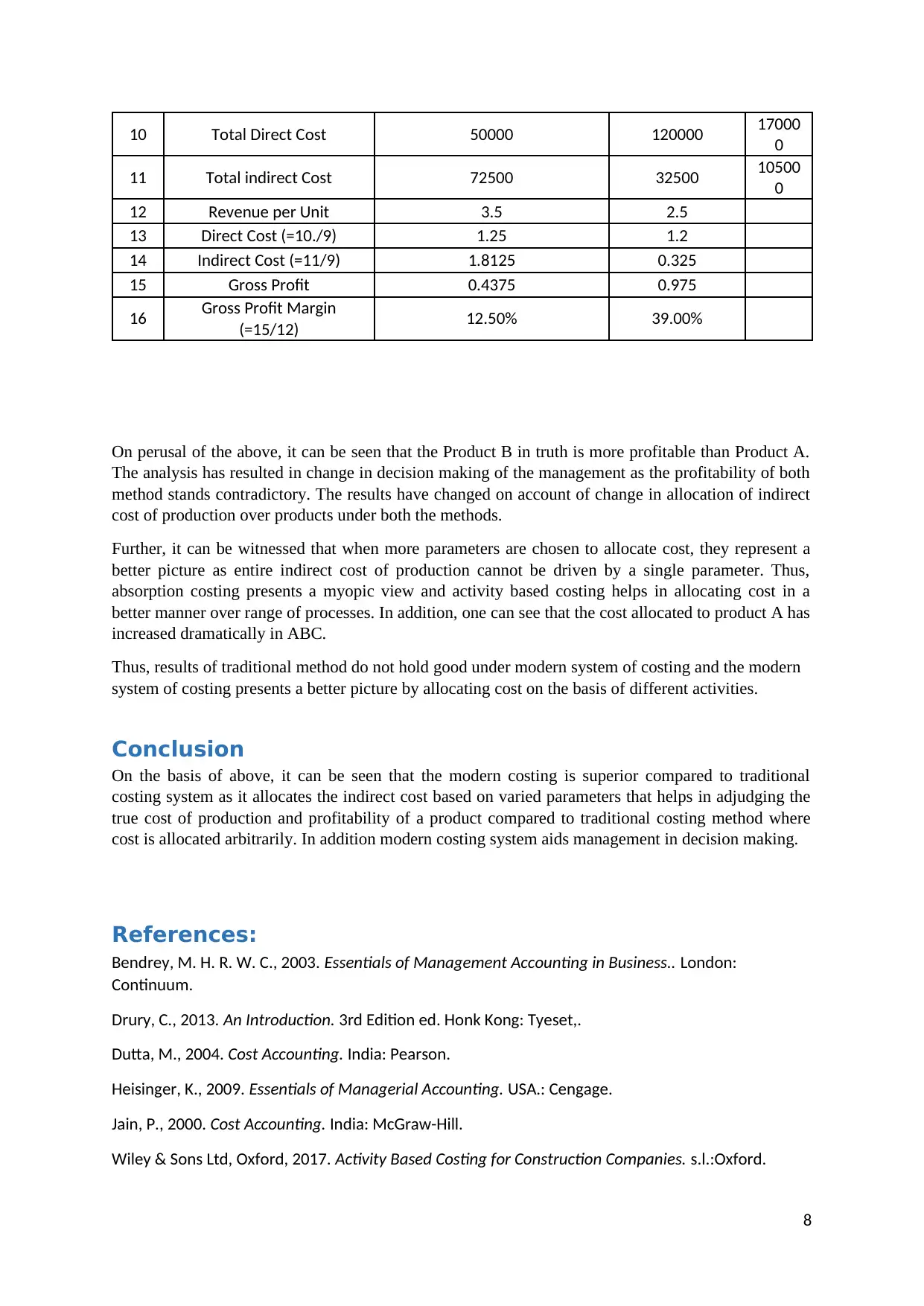
10 Total Direct Cost 50000 120000 17000
0
11 Total indirect Cost 72500 32500 10500
0
12 Revenue per Unit 3.5 2.5
13 Direct Cost (=10./9) 1.25 1.2
14 Indirect Cost (=11/9) 1.8125 0.325
15 Gross Profit 0.4375 0.975
16 Gross Profit Margin
(=15/12) 12.50% 39.00%
On perusal of the above, it can be seen that the Product B in truth is more profitable than Product A.
The analysis has resulted in change in decision making of the management as the profitability of both
method stands contradictory. The results have changed on account of change in allocation of indirect
cost of production over products under both the methods.
Further, it can be witnessed that when more parameters are chosen to allocate cost, they represent a
better picture as entire indirect cost of production cannot be driven by a single parameter. Thus,
absorption costing presents a myopic view and activity based costing helps in allocating cost in a
better manner over range of processes. In addition, one can see that the cost allocated to product A has
increased dramatically in ABC.
Thus, results of traditional method do not hold good under modern system of costing and the modern
system of costing presents a better picture by allocating cost on the basis of different activities.
Conclusion
On the basis of above, it can be seen that the modern costing is superior compared to traditional
costing system as it allocates the indirect cost based on varied parameters that helps in adjudging the
true cost of production and profitability of a product compared to traditional costing method where
cost is allocated arbitrarily. In addition modern costing system aids management in decision making.
References:
Bendrey, M. H. R. W. C., 2003. Essentials of Management Accounting in Business.. London:
Continuum.
Drury, C., 2013. An Introduction. 3rd Edition ed. Honk Kong: Tyeset,.
Dutta, M., 2004. Cost Accounting. India: Pearson.
Heisinger, K., 2009. Essentials of Managerial Accounting. USA.: Cengage.
Jain, P., 2000. Cost Accounting. India: McGraw-Hill.
Wiley & Sons Ltd, Oxford, 2017. Activity Based Costing for Construction Companies. s.l.:Oxford.
8
0
11 Total indirect Cost 72500 32500 10500
0
12 Revenue per Unit 3.5 2.5
13 Direct Cost (=10./9) 1.25 1.2
14 Indirect Cost (=11/9) 1.8125 0.325
15 Gross Profit 0.4375 0.975
16 Gross Profit Margin
(=15/12) 12.50% 39.00%
On perusal of the above, it can be seen that the Product B in truth is more profitable than Product A.
The analysis has resulted in change in decision making of the management as the profitability of both
method stands contradictory. The results have changed on account of change in allocation of indirect
cost of production over products under both the methods.
Further, it can be witnessed that when more parameters are chosen to allocate cost, they represent a
better picture as entire indirect cost of production cannot be driven by a single parameter. Thus,
absorption costing presents a myopic view and activity based costing helps in allocating cost in a
better manner over range of processes. In addition, one can see that the cost allocated to product A has
increased dramatically in ABC.
Thus, results of traditional method do not hold good under modern system of costing and the modern
system of costing presents a better picture by allocating cost on the basis of different activities.
Conclusion
On the basis of above, it can be seen that the modern costing is superior compared to traditional
costing system as it allocates the indirect cost based on varied parameters that helps in adjudging the
true cost of production and profitability of a product compared to traditional costing method where
cost is allocated arbitrarily. In addition modern costing system aids management in decision making.
References:
Bendrey, M. H. R. W. C., 2003. Essentials of Management Accounting in Business.. London:
Continuum.
Drury, C., 2013. An Introduction. 3rd Edition ed. Honk Kong: Tyeset,.
Dutta, M., 2004. Cost Accounting. India: Pearson.
Heisinger, K., 2009. Essentials of Managerial Accounting. USA.: Cengage.
Jain, P., 2000. Cost Accounting. India: McGraw-Hill.
Wiley & Sons Ltd, Oxford, 2017. Activity Based Costing for Construction Companies. s.l.:Oxford.
8
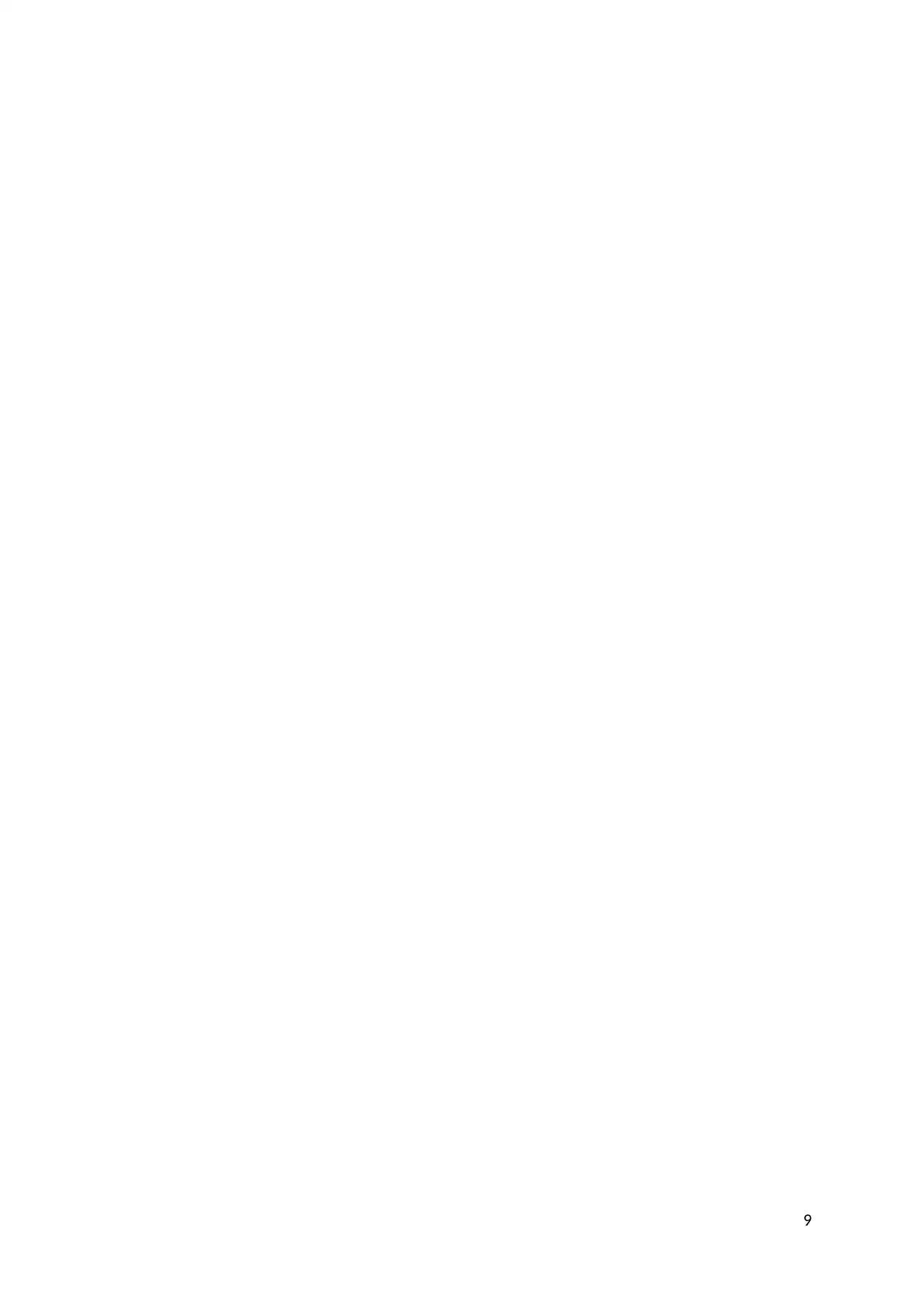
9
⊘ This is a preview!⊘
Do you want full access?
Subscribe today to unlock all pages.

Trusted by 1+ million students worldwide
1 out of 9
Related Documents
Your All-in-One AI-Powered Toolkit for Academic Success.
+13062052269
info@desklib.com
Available 24*7 on WhatsApp / Email
![[object Object]](/_next/static/media/star-bottom.7253800d.svg)
Unlock your academic potential
Copyright © 2020–2025 A2Z Services. All Rights Reserved. Developed and managed by ZUCOL.




